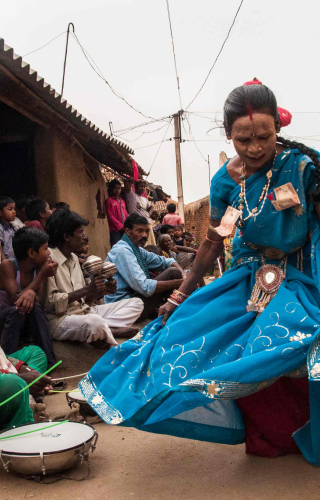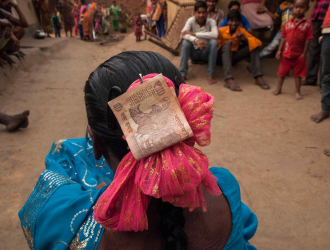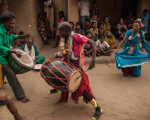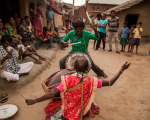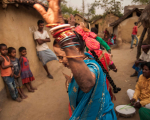The winds of Purulia resonate with songs and dance beats are inherent to the dry soil of this region. The rhythm of life and the rich natural environment consisting of gently undulating hills and forests of Sal, are reflected in the songs and dances. A special class of dancers, called nachni or bai, perform for the local population of Purulia and some parts of neighbouring Jharkhand. This rustic form of dance is accompanied by Jhumur song, another old performing art of the Chota Nagpur Plateau. Men sing in their deep, husky voices, and nachnis accompany the songs, maintaining the beat through rhythmic foot tapping, which gives this form its traditional name Jhumur (bells worn on the ankles).
Nachni is the remaining rump of the once dominant tawaif (nautch-girl) culture. Beginning in the first half of the 18th century, the position of a tawaif (colloquial term for a nautch girl) became highly respected within the Mughal elite. Tawaifs also flourished in Awadh, and further east in Varanasi and Calcutta (in these regions the colloquial term for a tawaif/nautch girl was baiji). During this period, the East India Company spread its rule in India and many early European officials married local tawaifs or kept them in their harems as courtesans. However, in the aftermath of the Great Mutiny of 1857, the Delhi and Awadh court was disbanded. During this same period social reformers were bringing in an era of enlightenment and female emancipation. Tawaifs became a symbol of medieval decadence.
Many famous tawaifs and baijis continued to dominate the urban cultural milieu well into the 20th century, when their popularity eventually declined with the coming of new mediums of entertainment in the form of theatre, gramophone, radio and cinema, and increasing participation of women in public life. Sensing the change in social dynamics, many tawaifs became popular singers and onstage actors. Others moved to the countryside where technology was slow to penetrate. This is how today’s nachni evolved. However, the social status of today’s nachni is a far cry from the tawaif or baiji of the past centuries. Earlier, the tawaifs held high status in society and were much valued for their taleem (training), tehzeeb (etiquette) and tameez (manners). In comparison, modern nachnis are impoverished and treated as social outcasts. During my interactions with the nachnis of Purulia, I wanted to know who these women are and why they are treated as cultural untouchables.
The nachni community is made up of young girls of the subaltern class. To make ends meet, they leave their home at a young age and take refuge under the patronage of a rasik. A rasik is actually a male Jhumur performer and a singer. Initially, these girls neither have any sense of aesthetics, nor do they possess any basic performance skills. It is the rasik who teaches them dance and the innuendo-laden songs. The rasiks improvise greatly while teaching their nachnis. The nachnis improvise too while performing live on stage.
During the performance the rasik controls the whole show, and participates in percussions and additional vocals. In many cases, the partnership on stage extends to real life and the nachnis over time become the live-in partner of the rasik and stays with the rasik under the same roof. Much like the maharajas, zamindars and babus of the past, the rasik has to find an alternative arrangement for his family and keep the two households separate. The care of their rasiks are the only source of relief in the life of nachnis, which however, comes at a cost. Though it is the nachni who performs on stage and attracts audiences, it is her rasik who has control over the earnings. Sometimes with advancing age or a disability, the rasik might abandon a nachni and find a younger replacement. This makes the position of a nachni highly insecure and subject to exploitation at the will of the rasik.
However, there is a silver lining. In recent times, the nachnis of Bengal are getting due respect and recognition. They have begun receiving aid and opportunities from the West Bengal government, including a monthly pension. Two senior-most performers, Bimala Devi and Pastubala Devi, have received special awards from the government. A Kolkata-based NGO, Durbar, is helping nachnis challenge the socio-cultural factors that perpetuate stigma, material deprivation and social exclusion. Due to such efforts, the children of the nachnis are getting the education and exposure they deserve. Recently, Pastubala Devi was invited to conduct a workshop on Jhumur at the Rabindra Bharati University.
Much though still needs to be done. As a performing art, it is not yet accepted as a cultural form. While performing onstage, a nachni portrays the role of Radha, while her rasik play the part of Krishna. Yet in real life, dancers who perform as Radha are treated as social outcasts. Neither do they receive much financial patronage nor do they get any institutional training. These cultural untouchables have long been neglected in spite of being an integral part of rural entertainment scene.
Through my photo essay, I have tried to investigate the life of the nachnis of rural Bengal—those who could not enjoy a proper family life or receive respect as artists. I hope my work brings about greater social awareness and collectively we can address such discrimination and neglect which permeates certain aspects of India's cultural heritage.
